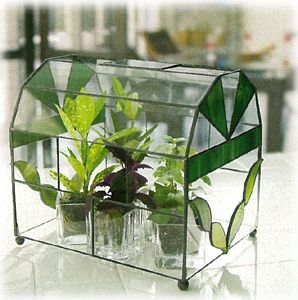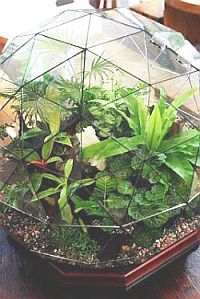Terrarium - miniature worlds in a bottle
|
|
|
|
A terrarium, by definition, is a garden under glass. This technique was very popular in Victorian times, and is now gaining new popularity. You can create all kinds of different landscapes, from a woodland scene to a desert or tropical jungle. You can even add water, insects or small animals and make a vivarium.
Creating a terrarium is an interesting and educational project, for it clearly illustrates how an ecosystem works. A terrarium is a closed ecosystem - like our planet, but on a smaller scale. Inside its glass walls, many different processes occur and interact: photosynthesis, respiration, and the water cycle.
A closed environment like this helps us better understand what impact living organisms and their environments have on each other. With the help of the sun's energy and photosynthesis, plants produce their own food. The water in the terrarium is constantly recycled, passing from liquid form to gas and back again, as the moisture in the air condenses on the glass walls, returns to the soil and is absorbed by the plants' roots.
Growing plants under glass or in a terrarium is an original way of coping with the problem of the dry air in our homes, since it provides a very humid environment for plants, making it possible to grow more demanding varieties. In addition, terrariums can be very decorative and make good gifts for people with pollen allergies.
Container
Terrarium The originality of a terrarium depends on the type of container you use, the plants you choose and the way you arrange them. Any glass container can serve as a terrarium, provided that it is transparent. You can recycle a large glass jar, a fish bowl or an old aquarium. Alternatively, there are some very attractive containers made of wood and glass or plastic available on the market.
Materials
It doesn't take much to set up a terrarium: fine gravel or coarse sand, charcoal chips, synthetic fabric (nylon) or screen to act as a soil separator, and potting mix appropriate to the plants used. If you wish to add a decorative touch, you can cover the soil with colored stone, bark chips or ground-cover plants.
Preparation
It is best to use a container with a neck wide enough so that you can reach inside with your hands. Wash and dry the container. Use a cardboard tube to gently pour in the materials, to keep the inside of the glass clean.
Since the containers used for terrariums have no drainage holes, a bottom layer of drainage material is needed to prevent water from standing in the soil. You can use fine gravel or coarse sand, in a layer 1.5 to 4 cm deep, depending on the size of your container.
Since a terrarium is a closed, damp environment, you will need to add charcoal to absorb any odors. Cover the gravel with about 1 cm of charcoal chips.
Cover the drainage material with a soil separator, e.g. a piece of synthetic fabric (nylon) or a screen trimmed so that the edges do not touch the glass walls. It will let the water drain through while preventing the potting mix from sifting down into the gravel.
Then add enough potting mix in which to root the plants. Use an appropriate mix: for example, desert plants prefer sandy soil, whereas for tropical plants it is best to add some perlite, vermiculite or peat moss.
There are certain rules of thumb to keep in mind. The base materials (drainage and potting mix) should ideally fill one-third to half the container, depending on its shape and size. The remaining space is for the plants.
Planting
Arrange the plants according to their size and growth habits. If the terrarium will be viewed from only one side, place the tallest plants in back. If it is to be seen from all sides, place the tallest plants in the middle.
Be careful not to overfill your terrarium - the plants will need room to grow. Make sure you leave enough space between them. Then you can add some surface decoration: moss, bark chips, stones or sand. Finally, water gently until the soil is evenly damp, but not soaked.
Choosing plants
The best plants for terrariums are small and slow-growing. Generally speaking, it is best to choose ones that complement each other in terms of their light, temperature and humidity requirements. For instance, high humidity in a sealed terrarium is well suited to ferns, mosses and insectivorous plants. Cacti and succulents, on the other hand, require a dryer environment and will flourish better in a container that is always kept open. Finally, you can control the humidity level by periodically opening and closing the lid of the terrarium to suit the plants' needs.
The following indoor plants grow well in terrariums. Combine species according to their light, temperature and humidity requirements. Be sure to choose healthy, insect-free plants, for parasites multiply quickly in the closed environment in a terrarium.
| Low Light | Medium Light | Bright Ligh |
| North | East | South and West |
| Aglaonema (fo) | Adiantum (f) | Begonia (fl) |
| Aucuba (fo) | Anthurium (fl) | Cactusi, suculente (fo) |
| Chamaedorea (fo) | Asplenium (f) | Dionaea (i) |
| Dracaena (fo) | Caladium (fo) | Episcia (fl) |
| Euonymus (fo) | Cladonia (l) | Gesneria (fl) |
| Calathea (fo) | Gaultheria (gc) | Iresine (fo) |
| Philodendron (fo) | Hedera (gc) | Oxalis (fl) |
| Pilea (fo) | Maranta (fo) | Saintpaulia (fl) |
| Sansevieria (fo) | Polypodium (f) | Sarracenia (i) |
| Scindapsus (fo) | Sarracenia (i) | Sinningia (fl) |
| Spathiphyllum (fo) | Selaginella (gc) | Streptocarpus (fl) |
| Syngonium (fo) | Sphagnum (m) | Trifolium (fl) |
Note:
fo: foliage, f: fern, m: moss, l: lichen, i: insectivorous, fl: flowering, gc: ground-cover.
Maintenance
Be careful not to over-water your terrarium, as this could cause the roots to rot and eventually kill the plants. Water infrequently, especially in closed containers. It is also a good idea to use distilled or filtered water for insectivorous plants, mosses and lichens, as they are highly sensitive to pollution.
Carnivorous plants like Venus's fly trap (Dionaea muscipula) and pitcher-plant (Sarracenia purpurea) are well-suited for terrarium planting but they require specific conditions and a dormancy period. It is also important to avoid collecting plants in the wild.
In a completely closed terrarium, water droplets may sometimes form on the walls after you have watered. If this happens, open the lid and allow the terrarium to dry out a bit. Fertilize once a month for healthy plant growth during the growing period, from April to September. Use a diluted organic fertilizer (7-7-7) like fish emulsion; synthetic fertilizers can cause salts to accumulate.
Remember to maintain your plants regularly as well, by removing dead leaves and branches before they start to rot. You may need to trim ground-cover plants if they become too invasive.
Finally, do not place your terrarium in full sunlight, for the sun's direct rays can burn the leaves.
Articole asemănătoare
-
Strugurii Blaufrankisch
Daca are suficient soare si un pamant fertil, Blaufrankisch sau Lemberger este o buna alegere pentru a obtine vinuri rosii de calitate, taninoase, aromate, cu note de fructe de padure, cu o nuanta inchisa, dar si pentru varietati mai usoare, fructate, vinuri de desert in care veti intalni gusturi si note surprinzatoare.
-
Garoafa, floarea celor nascuti in ianuarie
Toti cunoastem garoafele pentru ca fiecare am daruit candva un buchet de garoafe, insa putini stim ca ea este prin excelenta floarea persoanelor nascute in luna ianuarie.
-
Gradinaritul in saci, o solutie de viitor pentru combaterea saraciei
Rwanda este tara cu cea mai mare densitate a populatiei in Africa sub-sahariana. Numarul crescut de locuitori si deficitul de teren cultivabil constituie principalele probleme care determina cazurile de malnutritie. In jurul orasului Kigali, oamenii detin prea putin teren, sau mai rau decat atat, nu poseda nici macar un loc unde sa creasca produse vegetale.
-
De ce flori ne bucuram in noiembrie?
Desi vremea devine tot mai intunecata si mai rece in noiembrie, exista unele flori care prospera chiar si in aceste conditii dificile. Spre incredintare va prezentam o lista a celor mai populare flori care se intalnesc in perioada aceasta a anului in gradinile zonelor temperate ale globului.
-
Povestea bradului de Craciun
In cea din urma luna a fiecarui an bradul devine unul dintre elementele decorative cele mai importante pentru neamurile crestine.


